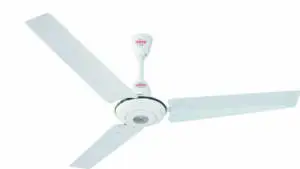Introduction
An AC DC fan is a multipurpose cooling device that may be powered by both alternating current (AC) and direct current (DC). It provides efficient airflow and cooling in various environments, including homes, offices, and industrial settings.
Benefits of AC DC Fans

AC DC fans offer several advantages over traditional fans that only operate on AC power. These benefits include:
- AC DC fans can be used in areas with limited or unreliable access to AC power, such as remote locations or during power outages. They can be powered by batteries, solar panels, or other DC power sources.
- They are designed to operate efficiently, consuming less power and reducing electricity bills compared to AC-only fans. They are an environmentally friendly cooling solution.
- They are often lightweight and portable, making them easy to move around and position in different areas. This feature is particularly useful for outdoor activities or when you need targeted cooling in specific areas.
- With the ability to switch between AC and DC power, these fans offer versatile usage options. You can use them as standalone fans or connect them to power sources like generators or inverters.
Understanding AC and DC Power
To better understand AC DC fans, it’s important to distinguish between AC and DC power:
- AC power is the type of electricity supplied by power grids. It constantly changes direction, flowing back and forth in a sine wave pattern.
- DC power flows continuously in a single direction, typically produced by batteries, solar panels, or other DC power sources. Many electronic devices, such as laptops and mobile phones, use DC power.
They can operate on both AC and DC power, providing flexibility and reliability in different situations.
Types of AC DC Fans
They come in various types, each suited for different purposes and environments. Let’s explore some common types:
4.1 Ceiling Fans
Ceiling fans are popular fixtures in homes and offices, providing overhead cooling and air circulation. AC DC ceiling fans can be connected to AC power for regular use and switched to DC power during power outages.
4.2 Pedestal Fans
Pedestal fans are freestanding fans with an adjustable height feature. They offer wide-area coverage and are commonly used in large rooms or outdoor spaces. AC DC pedestal fans provide cooling convenience regardless of the availability of AC power.
4.3 Table Fans
Table fans are compact and portable, making them ideal for personal cooling on desks, bedside tables, or countertops. AC DC table fans offer flexibility and can be powered by batteries or AC power, depending on the situation.
4.4 Tower Fans
Tower fans are tall, slim fans that provide a combination of space-saving design and effective cooling. They are suitable for small to medium-sized rooms and often feature oscillation and multiple speed settings. AC DC tower fans are a reliable cooling solution, even in areas without access to AC power.
4.5 Wall-Mounted Fans
Wall-mounted fans are fixed fans that are mounted on walls, offering a space-saving alternative to ceiling fans. AC DC wall-mounted fans can be connected to AC power as the primary source and switch to DC power during emergencies or power disruptions.
Factors to Consider When Choosing an AC DC Fan
When selecting an AC DC fan, several factors should considered to ensure you choose the right one for your needs. These factors include:
5.1 Fan Size and Design
Consider the size and design of the fan to ensure it aligns with your cooling requirements and the available space. Pay attention to dimensions, weight, and aesthetics.
5.2 Airflow and Cooling Capacity
Check the fan’s airflow and cooling capacity specifications, such as cubic feet per minute (CFM) and cooling range. Higher CFM values indicate better airflow and improved cooling efficiency.
5.3 Noise Level
If noise is a concern, look for fans with lower noise levels. Manufacturers often provide information about the decibel (dB) rating of their fans, allowing you to choose a quieter option.
5.4 Energy Efficiency
Opt for fans with high energy efficiency ratings to minimize electricity consumption. Look for features like adjustable speed settings, timers, and automatic shut-off to save energy.
5.5 Additional Features
Consider additional features that enhance convenience and usability, such as remote controls, oscillation capabilities, adjustable angles, and built-in timers. These features can improve your overall fan experience.
Installation and Maintenance Tips
Proper installation and maintenance are crucial for the optimal performance and longevity of your AC DC fan. Here are some tips to follow:
6.1 Installation Process
Follow the manufacturer’s instructions for installing your AC DC fan. Ensure proper electrical connections, stability, and secure mounting. If you’re uncertain, consider hiring a professional electrician for safe installation.
6.2 Cleaning and Maintenance
Regularly clean your fan to remove dust and debris that may accumulate over time. Additionally, inspect the fan for any signs of wear or damage and address them promptly to avoid potential issues.
Popular Brands and Models
Several reputable brands offer high-quality AC DC fans. Here are a few examples:
7.1 Brand A
- Model X: Features include adjustable height, oscillation, and remote control.
7.2 Brand B
- Model Y: Compact design with a rechargeable battery option for portable usage.
7.3 Brand C
- Model Z: Wall-mounted fan with multiple speed settings and energy-saving features.
These are just a few examples, and it’s recommended to explore other brands and models based on your specific requirements.
Conclusion
AC DC fans provide a versatile and efficient cooling solution for various settings. With the ability to operate on both AC and DC power, these fans offer flexibility, energy efficiency, and portability. When choosing an AC DC fan, consider factors such as fan size, airflow, noise level, energy efficiency, and additional features to ensure you select the right fan for your needs. For best performance and lifespan, proper installation and maintenance are also required.
Tere Bin 2 Announced, Fans Ecstatic with First Season Ending
